
Posted on 03/23/2017 6:49:41 PM PDT by sukhoi-30mki

Japan now has Asia’s only navy with two aircraft carrier-sized warships — the Kaga (pictured)
The state-controlled Chinese media has sharply criticised the commissioning of Japan’s powerful new warship, which has the same name --- Kaga --- as one of the Imperial Japanese Navy’s aircraft carriers in World War II.
The original Kaga, which Beijing’s English language daily, Global Times, terms a “notorious warship”, was sunk by the US Navy in the Battle of Midway in 1942.
With Japanese Ship (JS) Kaga’s rebirth on Wednesday as a “helicopter destroyer”, Japan now has Asia’s only navy with two aircraft carrier-sized warships --- the Kaga and its predecessor, JS Izumo. The 248 metre-long Kaga is larger than the Indian Navy’s INS Vikramaditya.
Additionally, Japan also operates two smaller helicopter destroyers, JS Haga and JS Ise, which are about the same weight class as the “Harrier carriers” that served the Italian, Spanish and Thai navies.
Beijing would also have noted last fortnight’s commissioning of Japan’s eighth Soryu-class submarine --- a massive 4,100-tonne vessel with air independent propulsion that many consider the world’s finest conventional submarine. With 11 older Oyashio-class submarines already in the fleet, Japan would have 23 submarines by 2021, when all 12 Soryu-class vessels are delivered.
Yet, the Japanese government, headed by the avowedly nationalist Shinzo Abe, still calls its navy the Japanese Maritime Self Defence Force (JMSDF). However, with China aggressively enforcing claims to disputed islands and waters in the Sea of Japan, East China Sea and South China Sea, Tokyo is gradually dropping the pretence.
Reuters has reported that JS Izumo will shortly lead a JMSDF naval task force on a three-month tour of the South China Sea, which the news agency terms the “biggest show of naval power in foreign waters in more than 70 years.”
JS Kaga, like its forerunner, JS Izumo, currently has a compliment of just nine helicopters. However, each vessel can embark 28 small, or 14 large aircraft. The helicopter carriers are not fitted with catapults or ski jumps for launching fixed wing fighters, but they could function as aircraft carriers by embarking vertical take-off fighters like the F-35B Lightening II.
Tokyo has a contradictory position on the use of military force. Its pacifist constitution, imposed on a defeated Japan by a victorious US after World War II, explicitly renounces war. It limits Japan’s defence spending to just one per cent of Gross Domestic Product (GDP) and prohibits it from acquiring offensive weapons platforms like aircraft carriers (helicopter carriers are passed off as defensive platforms).
On the other hand, the US today sees Japan as an ally against a resurgent China. Washington backs unapologetically nationalist leaders like Abe, who argue for shedding the US-imposed restraint. When President Donald Trump argued for allies like Japan to bear more of the cost of their defence he was, in effect, arguing for scuppering Japan’s one per cent spending cap.
Yet the JMSDF, despite its spending restraints, is widely considered Asia’s most powerful navy, even beating out China. Even with the one per cent spending cap, Japan has announced a defence budget for 2017 of $43.6 billion, only marginally smaller than India’s $53.5 billion.
Unlike India and China, Japan’s army does not consume the bulk of the budget --- the navy and air force do. In contrast, India’s navy was allocated just 14 per cent and the air force 22 per cent of the defence budget.
Furthermore, Japan’s sophisticated shipbuilding industry, including giants like Kawasaki Heavy Industries and Mitsubishi Heavy Industries, churn out warships fast and cheaply. Japan’s latest defence budget reveals they will build a new Soryu-class submarine for $685 million (India’s Scorpene submarines, less than half the Soryu’s size, costs about the same). Japan is building a 690-tonne, Awaji-class ocean minesweeper for just $160 million, and has budgeted $210 million for a 2,900-tonne Hibiki-class ocean surveillance ship.
For over a decade, the US has cajoled India and Tokyo into closer naval cooperation. Last year, Japan formally became a participant in the annual Malabar naval exercise, making it a US-India-Japan trilateral exercise.
There are bilateral proposals between New Delhi and Tokyo for the supply of Japanese defence equipment to India --- a touchy subject, given Japan’s constitution. On the table is the Japanese maritime sea-plane, the US-2; and the Soryu submarine.

Thanks for posting.
I was on one top heavy ship (USS Valley Forge) for an overnight engineering test. I hated the roll of that thing at slower speeds. Those Japanese carriers look insanely top heavy.
I think Midway was a battle where we beat a superior enemy by courage, determination and luck.
Japan’s early pilots and air crew were extremely well trained and also the cream of the crop. I remember Saburo Sakai said they were too hard. They washed out a lot of good pilots they could have used.
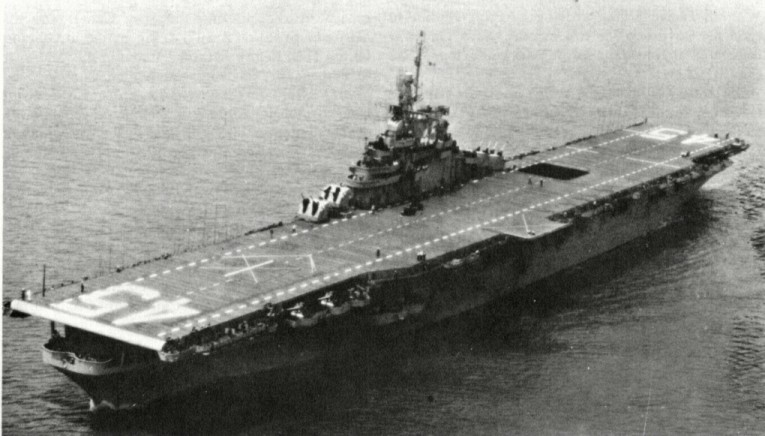
The smaller cruiser, of course. CG-50.
‘Luck’
Why not call it Providence ?
I sometimes wonder these days if our carriers are too big of a sitting duck. I have no inside information, so I don’t want to cast dispersion where none are warranted.
It is my take that moderate sized gunships with a multitude of guided missiles could possibly cause a massive amount of offensive damage, and with many of those instead of a few aircraft carriers, there might come a time when they would become more of a preference.
I toss this out there, to get some some feedback. I’m not against hearing this would not be as good a plan as I might think.
I just don’t like being in the position of having three or four of our aircraft carriers taken out, and being faced with a severely reduced fleet in short order.
Yes, LPH 8, but a very big ship. We (2/1) were doing landings up and down the coast of VN, when we were sent steaming to Indonesia during the coup to overthrow Sukarto in Sept of 65. The coup failed and they turned us back around, but we got caught up in Super Typhoon Bess. Now that was a rough ride. Two destroyers were following behind us and as we sat on the wooden flight deck, we watched as they disappeared for what seemed forever and popped back up like corks.
That’s Akagi. Island on the port side.
Here's F-35Bs operating off USS Navy Wasp class vessels":
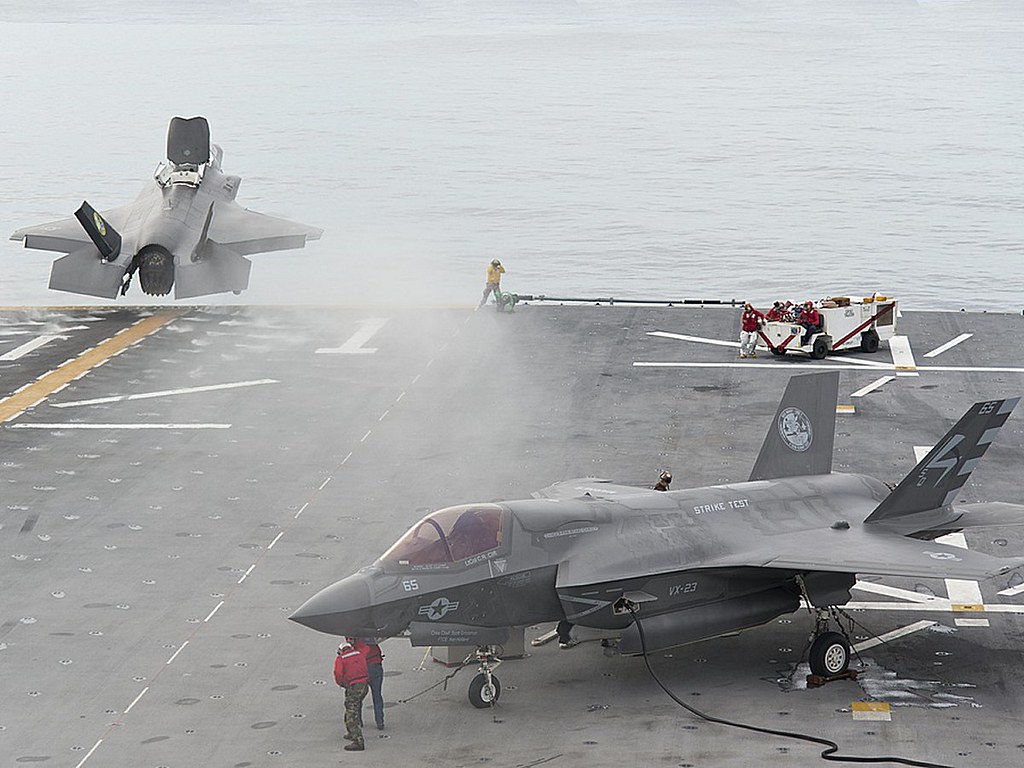
The Japanese carriers could probably carry 12 F-35Bs if the had to.
But the Chinese are building full size carriers and their second one is about to be launched.
They carry full on, fixed wing aircraft, not VTOL aircraft.
Here's their first one doing exercises in the Pacific last fall.
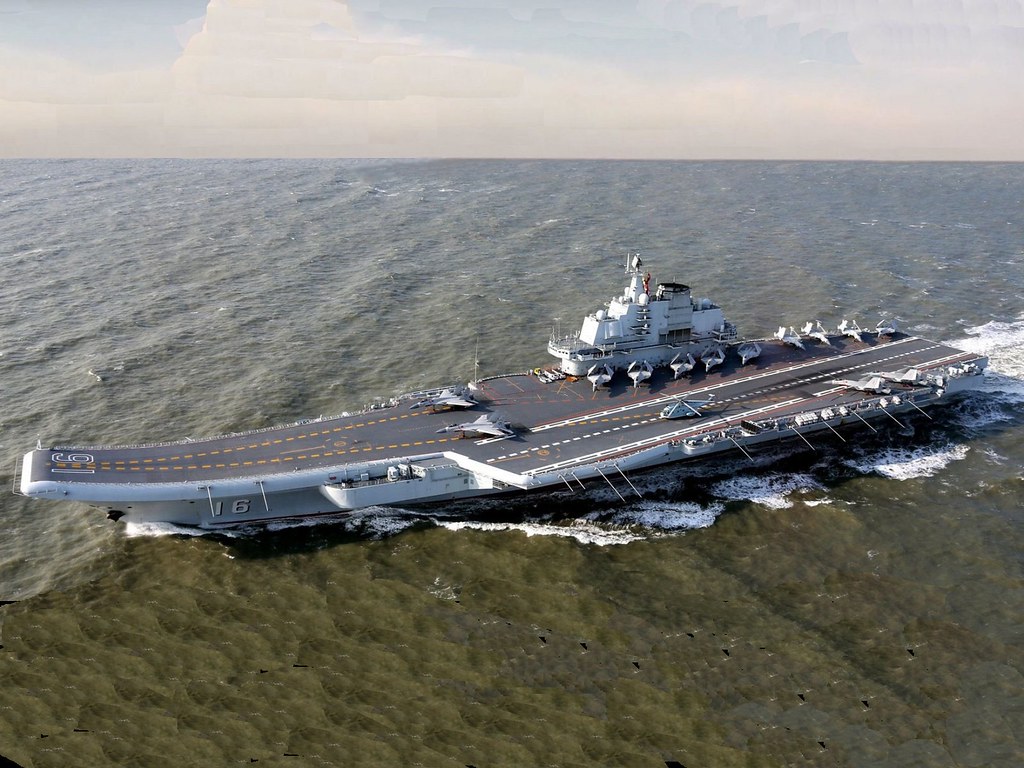
They are building carriers right now faster than we are (of course we are simply maintaining our count, while they are trying to play catch up). But they will have two of these by next year, and then they will come out with a regular cat and trap carrier two years later and another one of the full carriers like that two years after that.
An F-35B would be more than a match for those J-15s...but range is an issue when you have to vertically land and take off...although the F-35B would run the deck to help in the take off.
But the F-35C has already been to sea three times, passing its quals better than expected on full size US carriers.
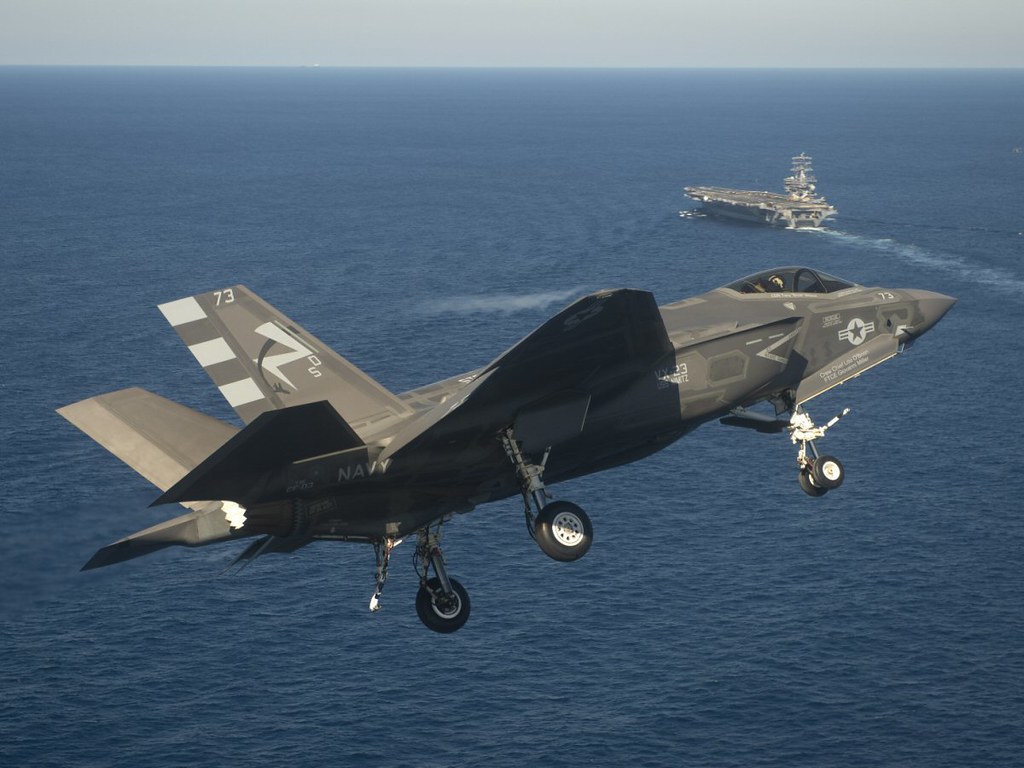
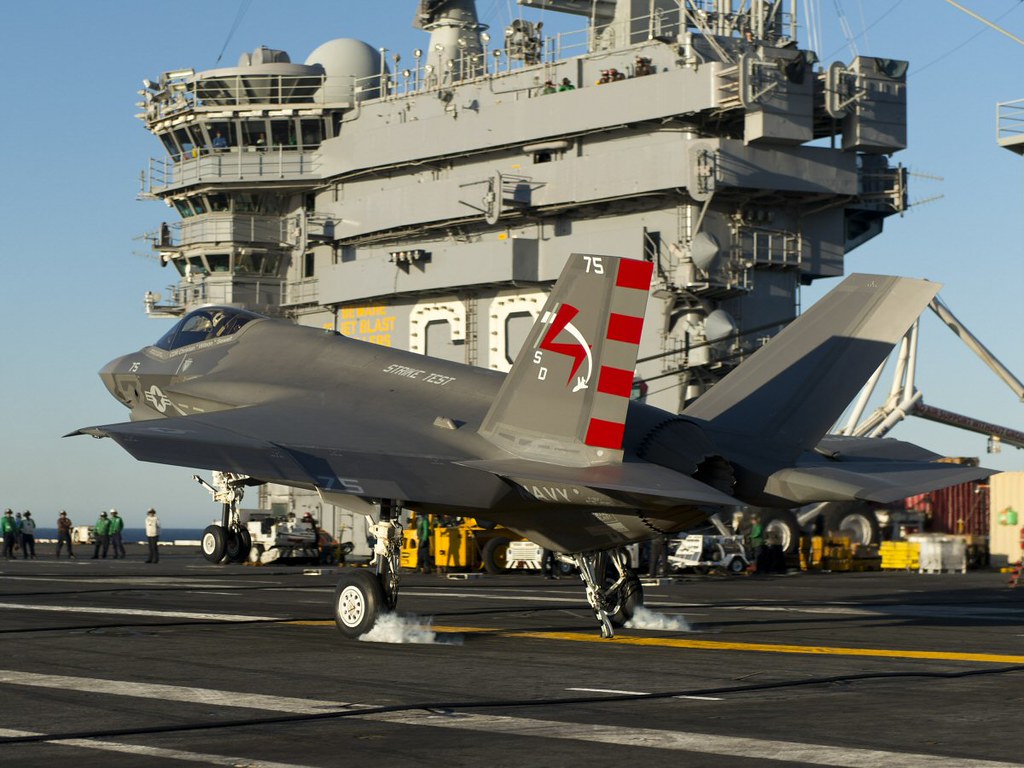
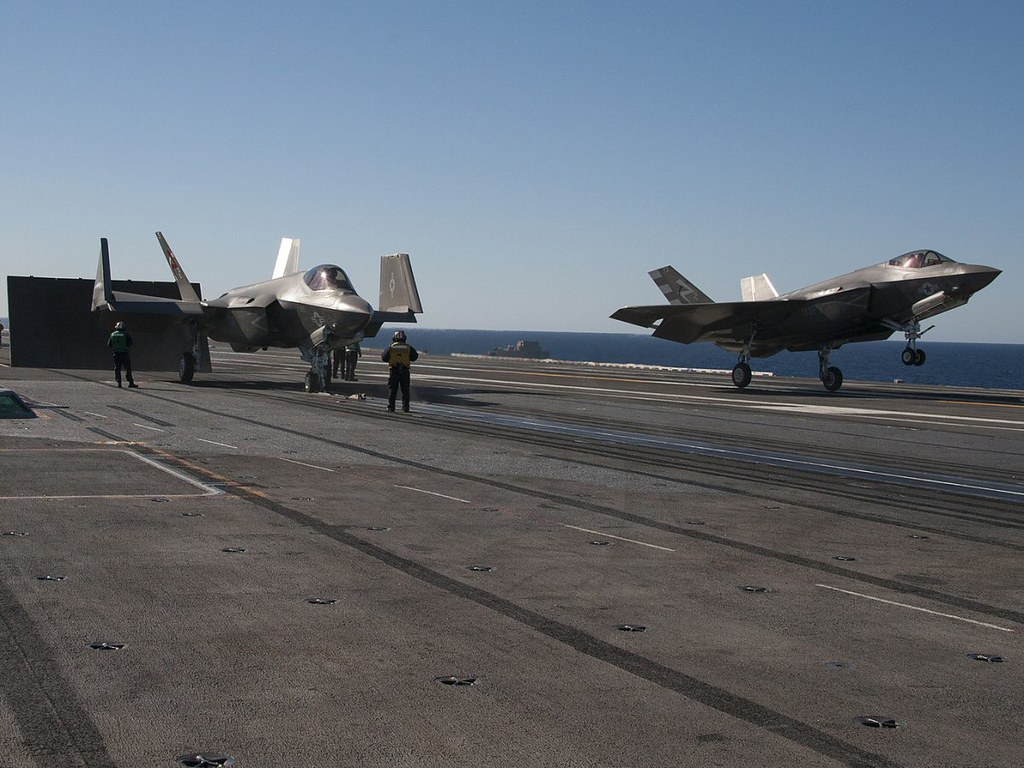
Make no mistake...the Chinese fear the F-35s. The US will field a 5th genertion, stealth arcraft off of the big carriers and the MArine Amphibious assault ships starting next year for the MArines...two to three years later for the Navy.
Japan could start buying the Bravo F-35 for its carriers any time and have them within a couple of years.
That has the chinese worried.
Because if Japan can do it, then the Koreans can have them on their Dokdo class vessels, and the Aussies can have them on their two new Canberra class vessels.
You know if China and Japan are thinking of going to war they would need to get on with it soon.
In a decade or so Japan will have no one but geriatrics to man their armed forces and China will have nothing but pampered “little emperor” only sons whose parents and grandparents having invested their entire lifetimes in rearing and educating them will be in no mood to send them off to be slaughtered as cannon fodder in the name of the great proletariat revolution.
It’s the underwater stealth subs that help keep big targets safe.
I never really checked around to see if any Japanese V/Stol has been tested or even proposed.
Ever since Midway people have questioned both single large carriers v. multiple small ones and putting multiple carriers together in a fleet as we did for the first Gulf War.
The single operational problem on the Chinese carriers is the size of their aircraft versus their elevator capability. One plane at a time and it barely fits. It takes a long time for them to rotate their planes into and out of the hanger.
“...LPH 8, but a very big ship. We (2/1) were doing landings up and down the coast of VN, .... but we got caught up in Super Typhoon Bess. Now that was a rough ride.....”
We (1/9) made a landing off Iwo Jima (LPH-2) in January ‘67. Not sure if a tropical storm or typhoon but weather prevented us from launching choppers for several days. Sitting on the hanger deck, in alternating motion the ship would roll to one side showing blue sky while the opposing view was darker blue ocean. Add to that the pitch of the ship and you had what seasickness is made of. Pitch and yaw. I came close but no cigar. Otherwise a nice ride. Sailors treated us great. Iwo was hands above previous rides like the Henrico, an APA.
We actually started out on the Iwo. It was only a year old and very cushy. Air conditioned bunks, mattresses on bunks, great chow, etc. Then they sent us to man the hills around Qui Nhon as the Army's 1st Cav came ashore. Then on to Subic, where we where transferred onto the Valley Forge. Old and dirty, with dirty stretched canvass for bunks. No air conditioning at all. Wouldn't have been so bad if we hadn't started out in such luxury.
Great post Jeff

Disclaimer: Opinions posted on Free Republic are those of the individual posters and do not necessarily represent the opinion of Free Republic or its management. All materials posted herein are protected by copyright law and the exemption for fair use of copyrighted works.